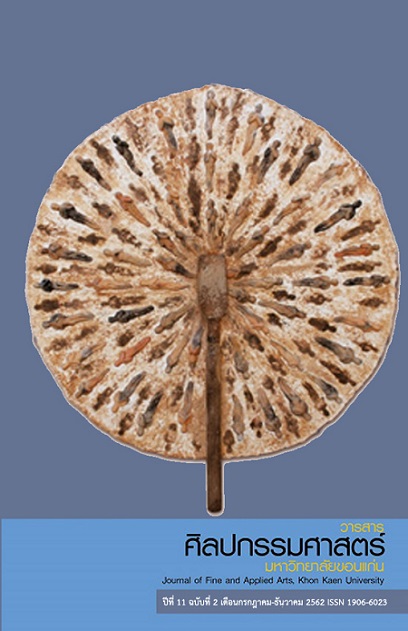การออกแบบชุดแต่งกายสำหรับสตรีไทดำจากอัตลักษณ์ไทดำนาป่าหนาด อำเภอเชียงคาน จังหวัดเลย
Main Article Content
บทคัดย่อ
การวิจัยนี้มีวัตถุประสงค์คือ 1) เพื่อศึกษาอัตลักษณ์การแต่งกายไทดำนาป่าหนาด อำเภอเชียงคาน จังหวัดเลย 2) เพื่อออกแบบชุดแต่งกายสตรีจากอัตลักษณ์การแต่งกายไทดำนาป่าหนาด และ3) เพื่อประเมินความพึงพอใจที่มีต่อชุดแต่งกายสตรีไทดำจากอัตลักษณ์การแต่งกายไทดำนาป่าหนาด โดยใช้เครื่องมือในการวิจัยได้แก่ แบบสอบถาม, แบบสัมภาษณ์เชิงลึก, และแบบประเมินผลความพึงพอใจที่มีต่อออกแบบชุดแต่งกายสำหรับสตรีไทดำจากอัตลักษณ์ไทดำนาป่าหนาด อำเภอเชียงคาน จังหวัดเลย กลุ่มตัวอย่างที่ใช้จำนวน 135 คน ได้แก่ ปราชญ์ชาวบ้านและผู้นำชุมชน 3 คน นักออกแบบแฟชั่นและเครื่องแต่งกาย หรืออาจารย์,ครูศิลปะ 2 คน นักท่องเที่ยวชาวไทยและชาวต่างชาติ 80 คน และชาวบ้านชุมชนบ้านนาป่าหนาด 50 คน ผลการวิจัยพบว่า 1) สตรีไทดำในปัจจุบันส่วนใหญ่นิยมใส่เสื้อผ้าร่วมสมัย จะสวมใส่ชุดประจำชาติพันธุ์สำหรับงานสำคัญหรือการส่งเสริมการท่องเที่ยว ผู้ตอบแบบประเมินที่เป็นเพศหญิงให้ข้อคิดเห็นว่าชุดประจำกลุ่มชาติพันธุ์โดยเฉพาะลายนางหาญถือเป็นลวดลายผ้าทอของหญิงชั้นสูงจึงนิยมใส่เมื่อมีงานสำคัญ 2) การออกแบบชุดแต่งกายสตรีจากอัตลักษณ์การแต่งกายไทดำนาป่าหนาด ใช้การวิเคราะห์โดยหลักการออกแบบ ได้แก่ด้านวัสดุ, ด้านสีสัน, ด้านลวดลาย,และด้านรูปแบบเครื่อง แต่งกาย และ 3) ผลการประเมินความพึงพอใจที่มีต่อชุดแต่งกายสำหรับสตรีไทดำจากอัตลักษณ์ไทดำนาป่าหนาด พบว่า มีความเหมาะสมโดยรวมอยู่ในระดับมาก ( =4.42)
Article Details
เนื้อหาและข้อมูลในบทความที่ลงตีพิมพ์ในวารสารคณะศิลปกรรมศาสตร์ มหาวิทยาลัยขอนแก่น ถือเป็นความคิดเห็นและความรับผิดชอบของผู้เขียนบทความโดยตรง ซึ่งกองบรรณาธิการไม่จำเป็นต้องเห็นด้วย หรือร่วมรับผิดชอบใด ๆ
บทความ ข้อมูล เนื้อหา รูปภาพ ฯลฯ ที่ได้รับการตีพิมพ์ในวารสารคณะศิลปกรรมศาสตร์ มหาวิทยาลัยขอนแก่น ถือเป็นลิขสิทธิ์ของวารสารคณะศิลปกรรมศาสตร์ มหาวิทยาลัยขอนแก่น หากบุคคลหรือหน่วยงานใดต้องการนำทั้งหมดหรือส่วนหนึ่งส่วนใดไปเผยแพร่ต่อหรือเพื่อกระทำการใด ๆ จะต้องได้รับอนุญาตเป็นลายลักอักษรจากวารสารคณะศิลปกรรมศาสตร์ มหาวิทยาลัยขอนแก่น ก่อนเท่านั้น
เอกสารอ้างอิง
ไทยโรจน์ พวงมณี และคณะ. (2557). แนวทางการส่งเสริมการท่องเที่ยวเพื่อการเรียนรู้วิถีชีวิตและวัฒนธรรมเมืองเชียงคาน จังหวัดเลย. กรุงเทพฯ : สำนักงานการท่องเที่ยวแห่งประเทศไทย.
ทรงพล ต่วนเทศ. (2555). การศึกษาภูมิปัญญาการทอผ้าพื้นเมืองของคนไทยเชื้อสายลาวครั่งในจังหวัดสุพรรณบุรี ชัยนาทและอุทัยธานี. วิทยานิพนธ์ปริญญามหาบัณฑิต สาขาวิชาศิลปศึกษา มหาวิทยาลัยศรีนครินทรวิโรฒ.
สำลาน กรมทอง. (2560). ผ้าลายนางหาญ. (เอกสารเผยแพร่แผ่นพับ). เลย : กลุ่มสตรีทอผ้าพื้นบ้านไทดำ (ฟื้นฟู).
สมชาย วรกิจเกษมสกุล. (2554). ระเบียบวิธีการวิจัยทางพฤติกรรมศาสตร์และสังคมศาสตร์. อุดรธานี: อักษรศิลป์ การพิมพ์.
สังคม พรมศิริ. (2551). ศึกษารูปแบบและสถานภาพการฟ้อนพื้นบ้านโบราณไทดำ บ้านนาป่าหนาด ตำบลเขาแก้ว อำเภอเชียงคาน จังหวัดเลย. กรุงเทพมหานคร : มหาวิทยาลัยราชภัฏเลย.
อริสา สุขสม. (2552). เมื่อวัยรุ่นบริโภคแฟชั่น : การบริโภค “อัตลักษณ์” ภายใต้วัฒนธรรมการบริโภค. วารสารสุทธิปริทัศน์, 23 (71) 7-32.
Chalyan, H. (2005). Hussein Chalayan. Groningen: Groninger Museum
McCracken, G. (1998). Cultural & Consumption. Bloomington : Indiana University Press.
Paul Sant Cassia. (2007). Bodies of Evidence: Burial, Memory, and the Recovery of Missing Persons in Cyprus, Berghahn Books, ISBN 978-1-84545-228-5, p. 237.
Sandra, B. (2011). Fashion designer concept to collection. China : Everbest.
Richard,S & Jenny,U. (2012). The Fundamentals of Fashion Design. Second edition AVA Publishing SA Rue Des Fontenailles 16 1000 Lausanne 6 Switzerland.


